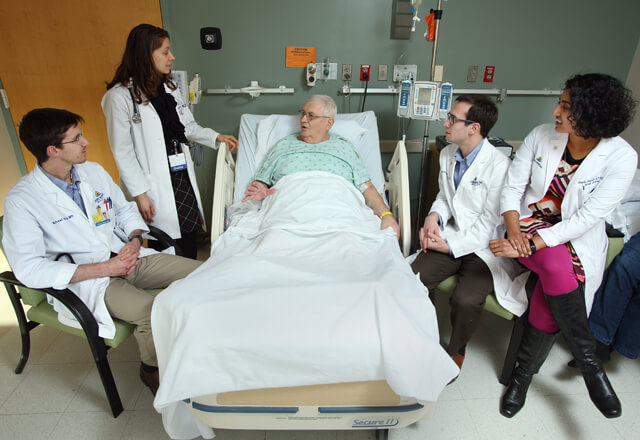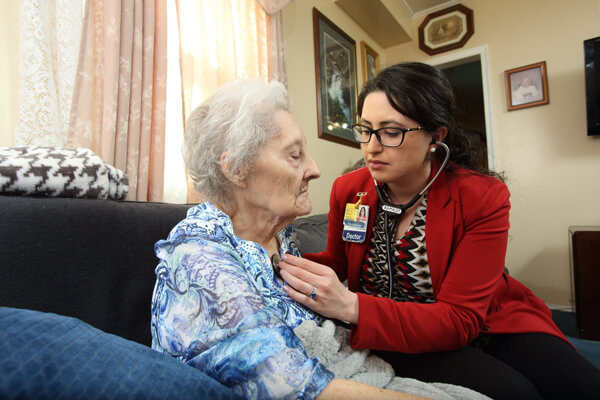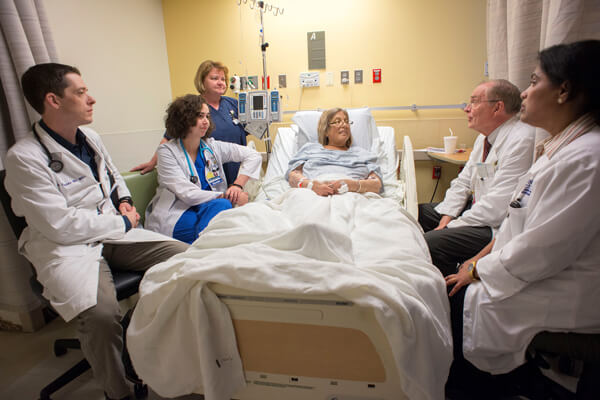Clinical Training Programs

The residency program offers both a "traditional" (i.e. categorical) and a primary care / general internal medicine (GIM) track. The PGY-1 experience for each track is identical and house staff from both tracks work "side-by-side" on inpatient rotations and in the resident's continuity clinic, the Randy Barker Medical Group (RBMG), a certified patient-centered medical home.
Beginning in the PGY-2 year, house staff who choose the GIM track have an expanded general medicine ambulatory experience and curriculum while those in the traditional program may tailor elective time to focus on one or more medical sub-specialties, perform research activities, or participate in the ambulatory components of the GIM program. There is flexibility in the program, and it is not uncommon for residents to change tracks during training as their learning objectives and career goals evolve.
- Categorical Internal Medicine Track
- Primary Care Internal Medicine Track
- Preliminary Medicine Training Program
Categorical Internal Medicine Track
The categorical internal medicine track is designed to train leaders in internal medicine and the medical sub-specialties. Residents are taught and mentored by outstanding clinicians and researchers who help prepare house staff to become excellent physicians.
Categorical residents are exposed to excellent training in diverse settings ranging from state-of-the-art medical and cardiac intensive care units to general internal medicine and sub-specialty clinics. The high faculty-to-resident ratio facilitates the formation of close relationships between housestaff and attending physicians, which are extraordinarily important to residents both during and after training. While general internal medicine residents spend much of their PGY-2 and PGY-3 years in ambulatory practice, categorical residents have considerable elective time that can be tailored to meet their evolving educational goals and career objectives.
Each resident in the categorical track is assigned an advisor to provide career and life guidance. In addition, each resident meets regularly with the program director who provides career advice and advocacy for the resident, either for fellowship application or another career path. Based on the resident's needs, the program director often facilitates meetings with local internal medicine or sub-specialty practitioners, allowing the resident to get a "bird's eye view" of life as an internist or sub-specialist in various settings.
We pride ourselves on being a program of academic excellence whose size and environment allow the resident to get the "personal touch." As a result of this focused mentoring and individual attention, combined with the academic excellence and reputation of our housestaff and the program, our residents have an unsurpassed record of obtaining sub-specialty fellowship programs at leading academic institutions of their choice.
Categorical Residents' Core Rotations Overview
Primary Care Internal Medicine Track
Established in 1979 as one of the first internal medicine primary care programs in the nation, Johns Hopkins Bayview's primary care internal medicine residency track has a rich history of training healers and leaders in general internal medicine. Compared with the categorical track, the primary care program offers a more extensive and varied outpatient continuity experience and primary care curriculum.
Graduates of the primary care internal medicine track commonly pursue careers in academic or community-based primary care practice, medical education, health policy and public health, health services research and medical subspecialties, such as geriatrics, where a strong grounding in outpatient primary care medicine is advantageous. We take great pride in tailoring the resident's experience to their individual career goals and objectives.

How This Track Helps Students
- Close Ties With The Johns Hopkins University Bloomberg School of Public Health. Several of our residents have collaborated with faculty and pursued projects at The Johns Hopkins University Bloomberg School of Public Health.
- Experiences That Meet Unique Career Interests. As a medium-sized residency at a major academic medical center, we cherish the ability to customize housestaff experiences to meet their individual interests. Many primary care residents have participated in unique experiences during their training that fit with their career interests and goals (e.g., Indian Health Service, global clinical and research electives, health policy work, etc.)
- Exposure to Ambulatory Sub-specialty Care and Didactic Topics. Primary care residents have increased time on outpatient blocks during their PGY-2 and PGY-3 years. This allows residents more time to practice at various continuity clinic sites, as well as gain exposure to ambulatory specialty care. These ambulatory blocks also allow for time for structured outpatient didactics.
- Fully Integrated With the Categorical Residency Track. Categorical and primary care residents are all part of one Johns Hopkins Bayview internal medicine family. Camaraderie is incredibly strong among all our housestaff. Primary care residents receive the same superb inpatient training as our categorical residents.
- Home-Based Ambulatory Care (Johns Hopkins Home-Based Medicine). Each primary care resident follows a panel of frail, home-bound elderly patients through home visits every third month, under the preceptorship of faculty from the Division of Geriatrics. This program is highly regarded by our residents and one of the oldest house-call programs in the country.
- Programmatic Support for Scholarly Work. We are happy to support residents in scholarly and professional pursuits. Our residents routinely present their work at regional and national meetings. In addition, the Johns Hopkins Biostatistics, Epidemiology and Data Management (BEAD) Core team is happy to assist housestaff with biostatistical support.
- Strong Community Engagement and Advocacy. At Johns Hopkins Bayview, one of our core values is that medicine is a public trust. We believe that providing good care for our patients does not end within the clinic or hospital walls. All of our residents participate in a unique longitudinal curriculum called Community-Oriented Primary Care (COPC). This curriculum is integrated into different aspects of the three years and integrates clinical medicine, epidemiology, social sciences and health service research in a complementary fashion to develop programs to meet the health needs of a community. In addition, our primary care residents often take leading roles in community engagement projects, many of which are a part of Medicine for the Greater Good.
- Two Robust Continuity Clinic Experiences. Primary care residents have two continuity clinic experiences during their residency training: a hospital-based continuity clinic at the Randy Barker Medical Group (RBMG) and a community-based continuity clinic site. The RBMG is the primary continuity clinic site for our residents and is located on the Johns Hopkins Bayview campus. Our program has partnerships with several different community-based continuity sites that serve unique patient populations. Based on preference, we happily connect residents to a site that best aligns with their goals and interests.
- Vast International Alumni Network. We are fortunate to have a tremendous Johns Hopkins Bayview family of primary care alumni that spans not only across the nation, but across the globe. Our alumni network is a great resource for our residents as they pursue training opportunities in various areas and as they embark on their future careers. Even after your residency training is done, you are always part of the Johns Hopkins Bayview family.
- World-Class Faculty. The faculty of the Division of General Internal Medicine at Johns Hopkins Bayview includes some of the nation's leading experts in primary care medicine, medical education, faculty development and mentoring. The authoritative textbook on outpatient medicine, Principles of Ambulatory Medicine, has been chiefly written by Johns Hopkins Bayview faculty. The opportunity to work closely with these faculty, as teachers, advisors and mentors, is one of the distinguishing features of the program.
Primary Care Residents' Core Rotations Overview
Preliminary Medicine Training Program

The Johns Hopkins Bayview residency program in internal medicine accepts six interns each year for a one-year preliminary year position. Preliminary year trainees have nearly the same schedule as other interns, except they do not have a mandatory ambulatory clinic experience. They benefit from the same outstanding clinical training, conferences and mentoring as all other interns.
Interns in the preliminary year generally go on to other specialty training, such as neurology, dermatology, ophthalmology, radiology, emergency medicine, anesthesiology, radiation oncology or rehabilitation medicine. Although preliminary year applicants have a variety of backgrounds, interests and career plans, by the end of internship, they all share the sense that they have experienced the most outstanding training experience in internal medicine in the country, and feel prepared to handle the challenge of their next residency.
For those applicants applying to the Johns Hopkins neurology residency who also are interested in a preliminary medicine position in our program, please note there is a unique ERAS code for a combined neurology-preliminary medicine position.
